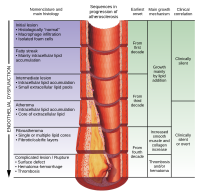
Photo from wikipedia
In the past several years, a significant body of work has been published in ATVB about new research in the field of vascular biology and redox signaling. We would like… Click to show full abstract
In the past several years, a significant body of work has been published in ATVB about new research in the field of vascular biology and redox signaling. We would like to highlight new publications that have enriched our understanding of redox signaling in the context of vasculopathy. Although redox balance and perturbation involve a plethora of proteins and signaling molecules, the focus of recent research has involved the examination of chemically reactive oxygen species (ROS), reactive nitrogen species (RNS), and the interactions with other molecules or enzymes that lead to vascular pathology.1,2 There are often a variety of downstream targets and mechanisms of cross-talk that can lead to pathologies observed in the vasculature as a result of redox imbalance. The objective of this article is to underscore the novel research in the field devoted to vascular redox physiology and disease. The main sources of vascular ROS are NAD(P)H oxidase (NOX),3 mitochondrial-derived superoxide (O2−),4 uncoupled nitric oxide synthase (NOS),5 and to a lesser extent xanthine oxidase,6 cyclooxygenase,7 and myeloperoxidase.8,9 A delicate ROS balance exists within the vascular wall that can be either beneficial or deleterious, depending on the source of ROS or the mechanisms of ROS capture or quenching, and these topics have been extensively discussed in previous reviews.10–12 ROS-associated proteins and their expression profiles vary in depending on vessel location within the vascular tree and tissue origin. Indeed, vascular smooth muscle cells (VSMC), endothelial cells, immune cells, and other hematopoietic cell types have vastly different expression patterns for the various ROS-related proteins. Moreover, these molecules readily change in response to stimuli and disease state.13–19 The balance between NOX protein expression and their role in disease is highly context and tissue …
Journal Title: Arteriosclerosis, Thrombosis, and Vascular Biology
Year Published: 2017
Link to full text (if available)
Share on Social Media: Sign Up to like & get
recommendations!